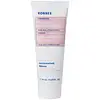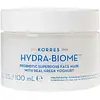What's inside
What's inside
 Key Ingredients
Key Ingredients

 Benefits
Benefits

 Concerns
Concerns

 Ingredients Side-by-side
Ingredients Side-by-side

Water
Skin ConditioningGlycerin
HumectantJojoba Esters
EmollientAlcohol Denat.
AntimicrobialGlycolic Acid
BufferingDistarch Phosphate
AbsorbentKaolin
AbrasivePunica Granatum Seed Powder
AbrasiveSimmondsia Chinensis Seed Oil
EmollientIsononyl Isononanoate
EmollientOryza Sativa Bran Oil
EmollientPentylene Glycol
Skin ConditioningCetearyl Alcohol
EmollientGlyceryl Stearate Citrate
EmollientHelianthus Annuus Seed Wax
Skin ConditioningSodium Hydroxide
BufferingSalix Alba Bark Extract
AstringentCaprylyl Glycol
EmollientCitrus Aurantifolia Fruit Extract
Skin ConditioningGlyceryl Caprylate
EmollientHamamelis Virginiana Leaf Extract
Skin ConditioningLactic Acid
BufferingLactobacillus/Punica Granatum Fruit Ferment Extract
Skin ConditioningLeuconostoc/Radish Root Ferment Filtrate
AntimicrobialPanthenol
Skin ConditioningParfum
MaskingPhenoxyethanol
PreservativePotassium Sorbate
PreservativeSodium Benzoate
MaskingSodium Polyacrylate
AbsorbentTetrasodium Glutamate Diacetate
Xanthan Gum
EmulsifyingWater, Glycerin, Jojoba Esters, Alcohol Denat., Glycolic Acid, Distarch Phosphate, Kaolin, Punica Granatum Seed Powder, Simmondsia Chinensis Seed Oil, Isononyl Isononanoate, Oryza Sativa Bran Oil, Pentylene Glycol, Cetearyl Alcohol, Glyceryl Stearate Citrate, Helianthus Annuus Seed Wax, Sodium Hydroxide, Salix Alba Bark Extract, Caprylyl Glycol, Citrus Aurantifolia Fruit Extract, Glyceryl Caprylate, Hamamelis Virginiana Leaf Extract, Lactic Acid, Lactobacillus/Punica Granatum Fruit Ferment Extract, Leuconostoc/Radish Root Ferment Filtrate, Panthenol, Parfum, Phenoxyethanol, Potassium Sorbate, Sodium Benzoate, Sodium Polyacrylate, Tetrasodium Glutamate Diacetate, Xanthan Gum
Water
Skin ConditioningYogurt
Skin ProtectingGlycerin
HumectantHexyldecyl Stearate
EmollientDiisostearyl Malate
EmollientPrunus Armeniaca Kernel Oil
MaskingSqualane
EmollientC14-22 Alcohols
Emulsion StabilisingIsoamyl Laurate
EmollientPrunus Amygdalus Dulcis Oil
Skin ConditioningArachidyl Alcohol
EmollientPentylene Glycol
Skin ConditioningButyrospermum Parkii Butter
Skin ConditioningPEG-100 Stearate
Aloe Barbadensis Leaf Juice Powder
Skin ConditioningAlgin
MaskingAlpha-Glucan Oligosaccharide
CleansingArachidyl Glucoside
EmulsifyingAscorbyl Palmitate
AntioxidantBehenyl Alcohol
EmollientBisabolol
MaskingC12-20 Alkyl Glucoside
EmulsifyingCaprylyl Glycol
EmollientChlorella Vulgaris Extract
Skin ConditioningDisodium Phosphate
BufferingEpigallocatechin Gallatyl Glucoside
AntioxidantEthylhexylglycerin
Skin ConditioningGallyl Glucoside
AntioxidantGlyceryl Polyacrylate
Helianthus Annuus Seed Oil
EmollientHydrogenated Palm Glycerides
EmollientHydrogenated Palm Kernel Glycerides
EmollientHydrolyzed Sodium Hyaluronate
Skin ConditioningHydroxyethyl Acrylate/Sodium Acryloyldimethyl Taurate Copolymer
Emulsion StabilisingLactic Acid
BufferingLactobacillus
Skin ConditioningLaminaria Digitata Extract
Skin ProtectingLecithin
EmollientLonicera Caprifolium Flower Extract
PerfumingLonicera Japonica Flower Extract
Skin ConditioningMaltodextrin
AbsorbentMaris Aqua
HumectantOzonized Oryza Sativa Callus Culture Extract
Skin ConditioningPhenethyl Alcohol
MaskingPolymnia Sonchifolia Root Juice
Skin ConditioningPotassium Phosphate
BufferingPropyl Gallate
AntioxidantPullulan
Saccharide Isomerate
HumectantSerine
MaskingSodium Carboxymethyl Beta-Glucan
CleansingSodium Hyaluronate
HumectantSodium Polyacrylate Starch
AbsorbentTetrasodium Glutamate Diacetate
Tocopherol
AntioxidantTrehalose
HumectantUrea
BufferingZingiber Officinale Root Extract
MaskingBenzyl Alcohol
PerfumingPhenoxyethanol
PreservativeSalicylic Acid
MaskingSorbic Acid
PreservativeParfum
MaskingWater, Yogurt, Glycerin, Hexyldecyl Stearate, Diisostearyl Malate, Prunus Armeniaca Kernel Oil, Squalane, C14-22 Alcohols, Isoamyl Laurate, Prunus Amygdalus Dulcis Oil, Arachidyl Alcohol, Pentylene Glycol, Butyrospermum Parkii Butter, PEG-100 Stearate, Aloe Barbadensis Leaf Juice Powder, Algin, Alpha-Glucan Oligosaccharide, Arachidyl Glucoside, Ascorbyl Palmitate, Behenyl Alcohol, Bisabolol, C12-20 Alkyl Glucoside, Caprylyl Glycol, Chlorella Vulgaris Extract, Disodium Phosphate, Epigallocatechin Gallatyl Glucoside, Ethylhexylglycerin, Gallyl Glucoside, Glyceryl Polyacrylate, Helianthus Annuus Seed Oil, Hydrogenated Palm Glycerides, Hydrogenated Palm Kernel Glycerides, Hydrolyzed Sodium Hyaluronate, Hydroxyethyl Acrylate/Sodium Acryloyldimethyl Taurate Copolymer, Lactic Acid, Lactobacillus, Laminaria Digitata Extract, Lecithin, Lonicera Caprifolium Flower Extract, Lonicera Japonica Flower Extract, Maltodextrin, Maris Aqua, Ozonized Oryza Sativa Callus Culture Extract, Phenethyl Alcohol, Polymnia Sonchifolia Root Juice, Potassium Phosphate, Propyl Gallate, Pullulan, Saccharide Isomerate, Serine, Sodium Carboxymethyl Beta-Glucan, Sodium Hyaluronate, Sodium Polyacrylate Starch, Tetrasodium Glutamate Diacetate, Tocopherol, Trehalose, Urea, Zingiber Officinale Root Extract, Benzyl Alcohol, Phenoxyethanol, Salicylic Acid, Sorbic Acid, Parfum
Alternatives
Ingredients Explained
These ingredients are found in both products.
Ingredients higher up in an ingredient list are typically present in a larger amount.
Caprylyl Glycol is a humectant and emollient, meaning it attracts and preserves moisture.
It is a common ingredient in many products, especially those designed to hydrate skin. The primary benefits are retaining moisture, skin softening, and promoting a healthy skin barrier.
Though Caprylyl Glycol is an alcohol derived from fatty acids, it is not the kind that can dry out skin.
This ingredient is also used as a preservative to extend the life of products. It has slight antimicrobial properties.
Learn more about Caprylyl GlycolGlycerin is already naturally found in your skin. It helps moisturize and protect your skin.
A study from 2016 found glycerin to be more effective as a humectant than AHAs and hyaluronic acid.
As a humectant, it helps the skin stay hydrated by pulling moisture to your skin. The low molecular weight of glycerin allows it to pull moisture into the deeper layers of your skin.
Hydrated skin improves your skin barrier; Your skin barrier helps protect against irritants and bacteria.
Glycerin has also been found to have antimicrobial and antiviral properties. Due to these properties, glycerin is often used in wound and burn treatments.
In cosmetics, glycerin is usually derived from plants such as soybean or palm. However, it can also be sourced from animals, such as tallow or animal fat.
This ingredient is organic, colorless, odorless, and non-toxic.
Glycerin is the name for this ingredient in American English. British English uses Glycerol/Glycerine.
Learn more about GlycerinLactic Acid is another well-loved alpha hydroxy acid (AHA). It is gentler than glycolic acid but still highly effective.
Its main role is to exfoliate the surface of the skin by loosening the “glue” that holds dead skin cells together. Shedding those old cells leads to smoother, softer, and more even-toned skin.
Because lactic acid molecules are larger than glycolic acid, they don’t penetrate as deeply. This means they’re less likely to sting or irritate, making it a great choice for beginners or those with sensitive skin.
Like glycolic acid, it can:
Lactic acid also acts as a humectant (like hyaluronic acid). It can draw water into the skin to improve hydration and also plays a role in the skin's natural moisturizing factor (NMF) in the form of sodium lactate.
Studies show it can boost ceramide production to strengthen the skin barrier and even help balance the skin’s microbiome.
To get results, choose products with a pH between 3-4.
Lower strengths (5-12%) focus on surface exfoliation; higher strengths (12% and up) can reach deeper in the dermis (deeper, supportive layer) to improve skin texture and firmness over time.
Though it was originally derived from milk, most modern lactic acid used in skincare is vegan. It is made through non-dairy fermentation to create a bio-identical and stable form suitable for all formulations.
When lactic acid shows up near the end of an ingredient list, it usually means the brand added just a tiny amount to adjust the product’s pH.
Legend has it that Cleopatra used to bathe in sour milk to help reduce wrinkles.
Lactic acid is truly a gentle multitasker: it exfoliates, hydrates, strengthens, and brightens. It's a great ingredient for giving your skin a smooth, glowing, and healthy look without the harshness of stronger acids.
Read more about some other popular AHA's here:
Learn more about Lactic AcidParfum is a catch-all term for an ingredient or more that is used to give a scent to products.
Also called "fragrance", this ingredient can be a blend of hundreds of chemicals or plant oils. This means every product with "fragrance" or "parfum" in the ingredients list is a different mixture.
For instance, Habanolide is a proprietary trade name for a specific aroma chemical. When used as a fragrance ingredient in cosmetics, most aroma chemicals fall under the broad labeling category of “FRAGRANCE” or “PARFUM” according to EU and US regulations.
The term 'parfum' or 'fragrance' is not regulated in many countries. In many cases, it is up to the brand to define this term.
For instance, many brands choose to label themselves as "fragrance-free" because they are not using synthetic fragrances. However, their products may still contain ingredients such as essential oils that are considered a fragrance by INCI standards.
One example is Calendula flower extract. Calendula is an essential oil that still imparts a scent or 'fragrance'.
Depending on the blend, the ingredients in the mixture can cause allergies and sensitivities on the skin. Some ingredients that are known EU allergens include linalool and citronellol.
Parfum can also be used to mask or cover an unpleasant scent.
The bottom line is: not all fragrances/parfum/ingredients are created equally. If you are worried about fragrances, we recommend taking a closer look at an ingredient. And of course, we always recommend speaking with a professional.
Learn more about ParfumPentylene glycol is typically used within a product to thicken it. It also adds a smooth, soft, and moisturizing feel to the product. It is naturally found in plants such as sugar beets.
The hydrophilic trait of Pentylene Glycol makes it a humectant. As a humectant, Pentylene Glycol helps draw moisture from the air to your skin. This can help keep your skin hydrated.
This property also makes Pentylene Glycol a great texture enhancer. It can also help thicken or stabilize a product.
Pentylene Glycol also acts as a mild preservative and helps to keep a product microbe-free.
Some people may experience mild eye and skin irritation from Pentylene Glycol. We always recommend speaking with a professional about using this ingredient in your routine.
Pentylene Glycol has a low molecular weight and is part of the 1,2-glycol family.
Learn more about Pentylene GlycolPhenoxyethanol is a preservative that has germicide, antimicrobial, and aromatic properties. Studies show that phenoxyethanol can prevent microbial growth. By itself, it has a scent that is similar to that of a rose.
It's often used in formulations along with Caprylyl Glycol to preserve the shelf life of products.
Tetrasodium Glutamate Diacetate is a chelating agent. Chelating agents help prevent metal ions from binding to other ingredients. This helps prevent unwanted effects and reactions from a product. These metal ions may come from water and are found in miniscule amounts.
Tetrasodium Glutamate Diacetate can also help other preservatives be more effective.
Water. It's the most common cosmetic ingredient of all. You'll usually see it at the top of ingredient lists, meaning that it makes up the largest part of the product.
So why is it so popular? Water most often acts as a solvent - this means that it helps dissolve other ingredients into the formulation.
You'll also recognize water as that liquid we all need to stay alive. If you see this, drink a glass of water. Stay hydrated!
Learn more about Water